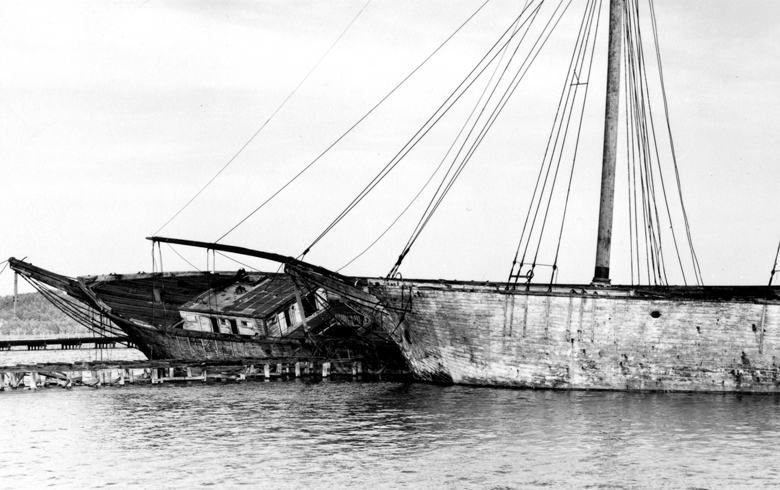For more than 60 years, the four-mast schooners Hesper and Luther Little lay abandoned in the Sheepscot River. Better known as the “Wiscasset Schooners,” they served as an iconic landmark to millions of passersby travelling on Maine’s coastal Route 1.
The sight of these schooners charmed the masses, stirring visions of life at sea and serving as reminders of Maine’s historic role in commercial shipping. Some actually believe them to be the most photographed vessels in the world with countless snapshots residing in the scrapbooks and slide carousels documenting decades of Maine tourism.
How the schooners came to be in Wiscasset is rooted in the story of the decline of sail.
Although steel, steam-powered vessels had been replacing wooden sailing vessels for some time in commercial shipping, a renewed demand for wooden vessels emerged in World War I. It was during this time that both Hesper and Luther Little were constructed. After the war, the need for such vessels continued to dwindle.
While some smaller commercial vessels experienced second careers as windjammers, countless seaworthy vessels fell into obscurity and became coal barges, were scuttled as breakwaters, or simply scrapped.
After spending several idle years anchored in Maine ports, Frank W. Winter of Auburn purchased Hesper and Luther Little for $600 each in 1932. Winter had also acquired the Wiscasset, Waterville & Farmington Railroad with a plan to operate a lumber company.
Until 1936 the schooners were tied up to a pier where the current town landing is located. When it became apparent that Winter’s plans were not going to pan out, they were moved to their final berth only slightly north of the pier—a backdrop to Wiscasset’s downtown village.
The Wiscasset Schooners certainly were not the only example of abandoned vessels in Maine waters, but no other claimed such a prominent location. Thousands climbed aboard the schooners for photo ops and this was made easier while the dock (pictured here in about 1945) was still intact. Determined explorers eventually had to brave the mud at low tide to gain access. As the condition of the schooners degraded over time, the hazards to those clambering on board multiplied. In recognition of their draw, a group unsuccessfully campaigned to stabilize the vessels in the 1970s.
Vandalism, fires, the elements, and severe weather events continued to take their toll. By the mid-1990s, the Wiscasset Schooners had fully transformed from romantic relics of the Maine coast to rubble in the mud. Ultimately, the town of Wiscasset took responsibility for the 1998 excavation and gradual disposal of Hesper’s and Luther Little’s remains.
Fragments of the rigging made their way into the collection of Maine Maritime Museum, providing important examples of shipbuilding techniques common in Maine shipyards. Less distinguishable pieces were made available to the public at the Wiscasset landfill. Perhaps the most notable repurposing is Luther Little’s salvaged Douglas fir masts transformed into custom kitchen cabinets.
Kelly Page is collections and library services manager for Maine Maritime Museum in Bath. Current exhibits include “Zach Horn: Looking for Winslow Homer” and “Uncharted: Maine Artists/Maine Waters.” Explore resources and plan your visit at www.MaineMaritimeMuseum.org.





